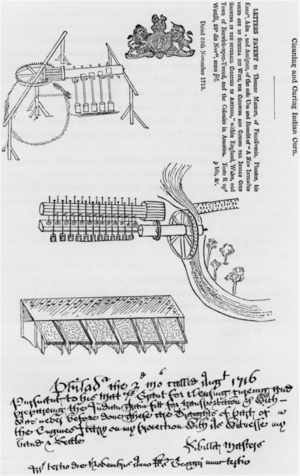Sybilla Righton Masters facts for kids
Sybilla Righton Masters (born around 1676 – died August 23, 1720) was an amazing American inventor. She was the first person living in the American colonies to receive an English patent. She might also be the first known white female inventor of machines in America.
In 1715, Sybilla Masters received a patent for a corn mill. This patent was given in her husband's name because women were not allowed to have their own patents back then. She also invented a new way to make hats, which she patented too.
Who Was Sybilla Masters?
Not much is known about Sybilla Masters' early life. She might have been born in Bermuda. Her father moved from Bermuda in 1687. It is thought she was born around 1676.
In 1687, she and her six sisters moved from Bermuda to Burlington Township, New Jersey. They lived along the Delaware River with their Quaker parents, Sarah and William Righton. Sybilla Righton first appeared in official records in 1692. She was a witness for her father in the New Jersey courts.
Between 1693 and 1696, Sybilla married Thomas Masters. He was a successful Quaker businessman and landowner. They had four children: Mary, Sarah, Thomas, and William.
A Trip to London for Ideas
On June 24, 1712, Sybilla Masters left her family. She traveled all the way to London to get patents for her invention ideas. In 1712, some American colonies were giving out patents. However, Pennsylvania, where she lived, was not one of them.
On November 25, 1715, King George I of Great Britain granted her patent. It was for a process to "Clean and Cure The Indian Corn." This patent was given in her husband's name, as was the custom for women inventors then.
If not for her husband, Thomas Masters, Sybilla Masters' name might have been forgotten. Thomas Masters clearly stated in the patent request that the idea was hers. When the patent was given, King George I publicly announced it was her invention.
Sybilla Masters received her second patent, again in her husband's name. This one was for a way to weave straw and palmetto leaves into hats and bonnets. She opened a shop in London using this new method. Her hats and bonnets became very popular. Sybilla Masters returned home to Pennsylvania on May 25, 1716.
What Did Sybilla Invent?
Sybilla Masters' first patent was for a new way to prepare cornmeal. Instead of grinding, her method used a stamping process. Her machine had a long wooden cylinder with parts that made heavy pestles drop onto corn kernels. This machine could be powered by horses or water wheels.
The product she made was called "Tuscarora Rice." It was advertised as a cure for tuberculosis, which was not true. While it wasn't popular in England, it became a common food in the southeastern United States. Today, we know this product as grits.
Sybilla Masters' second patent was for a new way to make hats and bonnets. She used straw and palmetto leaves. This process was also used to create other woven items. These included baskets, floor mats, and even furniture covers.
See also
- Timeline of United States inventions (before 1890)


